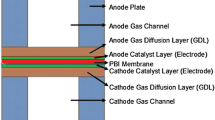Abstract
An optimization study using a comprehensive 3D, multi-phase, non-isothermal model of a PEM (proton exchange membrane) fuel cell that incorporates significant physical processes and key parameters affecting fuel cell performance is presented and discussed in detail. The model accounts for both gas and liquid phase in the same computational domain, and thus allows for the implementation of phase change inside the gas diffusion layers. The model includes the transport of gaseous species, liquid water, protons, energy, and water dissolved in the ion-conducting polymer. Water is assumed to be exchanged among three phases: liquid, vapour, and dissolved, with equilibrium among these phases being assumed. This model also takes into account convection and diffusion of different species in the channels as well as in the porous gas diffusion layer, heat transfer in the solids as well as in the gases, and electrochemical reactions. The results showed that the present multi-phase model is capable of identifying important parameters for the wetting behaviour of the gas diffusion layers and can be used to identify conditions that might lead to the onset of pore plugging, which has a detrimental effect on the fuel cell performance. This model is used to study the effects of several operating, design, and material parameters on fuel cell performance. Detailed analyses of the fuel cell performance under various operating conditions have been conducted and examined.
Similar content being viewed by others
References
Bernardi, D.M., Verbrugge, M.W., 1992. A mathematical model of the solid-polymer-electrolyte fuel cell. J. Electrochem. Soc., 139(9):2477–2491. [doi:10.1149/1.2221251]
Berning, T., Djilali, N., 2003a. 3D computational analysis of transport phenomenon in a PEM fuel cell-A parametric study. J. Power Sources, 124(2):440–452. [doi:10.1016/S0378-7753(03)00816-4]
Berning, T., Djilali, N., 2003b. A 3D, multi-phase, multi-component model of the cathode and anode of a PEM fuel cell. J. Electrochem. Soc., 150(12):A1589–A1598. [doi:10.1149/1.1621412]
Berning, T., Lu, D.M., Djilali, N., 2002. 3D computational analysis of transport phenomena in a PEM fuel cell. J. Power Sources, 106(1–2):284–294. [doi:10.1016/S0378-7753(01)01057-6]
Coppo, M., Siegelb, N.P., von Spakovskyc, M.R., 2005. On the influence of temperature on PEM fuel cell operation. J. Power Sources, 159(1):560–569. [doi:10.1016/j.jpowsour.2005.09.069]
Fuller, E.N., Schettler, P.D., Giddings, J.C., 1966. A new methode for prediction of binary gas-phase diffusion coefficients. Ind. Eng. Chem., 58(5):18–27. [doi:10.1021/ie50677a007]
Gurau, V., Liu, H., Kakac, S., 1998. 2D model for proton exchange membrane fuel cells. AIChE Journal, 44(11):2410–2422. [doi:10.1002/aic.690441109]
Hirschenhofer, J.H., Stauffer, D.B., Engleman, R.R., Klett, M.G., 2002. Fuel Cell Handbook, DOE/NETL-2002/1179 (DE-AM26-99FT40575), U.S. Department of Fossil Energy, Morgantown Energy Technology Center, Morgantown, WV, Chapter 2, p. 11–12.
Hu, M., Gu, A., Wang, M., Zhu, X., Yu, L., 2004a. Three dimensional, two phase flow mathematical model for PEM fuel cell. Part I. Model development. Energy Conversion Manage, 45(11–12):1861–1882. [doi:10.1016/j.enconman.2003.09.022]
Hu, M., Gu, A., Wang, M., Zhu, X., Yu, L., 2004b. Three dimensional, two phase flow mathematical model for PEM fuel cell. Part II. Analysis and discussion of the internal transport mechanisms. Energy Conversion and Management, 45(11–12):1883–1916. [doi:10.1016/j.enconman.2003.09.023]
Ju, H., Meng, H., Wang, C.Y., 2005. A single-phase, non-isothermal model for PEM fuel cells. Int. J. Heat and Mass Transfer, 48(7):1303–1315. [doi:10.1016/j.ijheatmasstransfer.2004.10.004]
Lampinen, M.J., Fomino, M., 1993. Analysis of free energy and entropy changes for half-cell reactions. J. Electrochem. Soc., 140(12):3537–3546. [doi:10.1149/1.2221123]
Nguyen, P.T., Berning, T., Djilali, N., 2004. Computational model of a PEM fuel cell with serpentine gas flow channels. J. Power Sources, 130(1–2):149–157. [doi:10.1016/j.jpowsour.2003.12.027]
Parthasarathy, A., Srinivasan, S., Appleby, J.A., Martin, C.R., 1992. Pressure dependence of the oxygen reduction reaction at the platinum microelectrode/nafion interface: electrode kinetics and mass transport. J. Electrochem. Soc., 139(10):2856–2862. [doi:10.1149/1.2068992]
Siegel, N.P., Ellis, M.W., Nelson, D.J., von Spakovsky, M.R., 2004. A 2D computational model of a PEMFC with liquid water transport. J. Power Sources, 128(2):173–184. [doi:10.1016/j.jpowsour.2003.09.072]
Sivertsen, B.R., Djilali, N., 2005. CFC based modelling of proton exchange membrane fuel cells. J. Power Sources, 141(1):65–78. [doi:10.1016/j.jpowsour.2004.08.054]
Springer, T.E., Zawodzinski, T.A., Gottesfeld, S., 1991. Polymer electrolyte fuel cell model. J. Electrochem. Soc., 138(8):2334–2342. [doi:10.1149/1.2085971]
Stanic, V., Hoberech, M., 2004. Mechanical of Pin-hole Formation in Membrane Electrode Assemblies for PEM Fuel Cells. Proceedings of the Fourth International Symposium on Proton Conducting Membrane Fuel Cells.
Sui, P., Djilali, N., 2005. Analysis of watertransport in proton exchange membranes using a phenomenological model. J. Fuel Cell Sci. & Tech. ASME, 2(1):149–155. [doi:10.1115/1.1895945]
Tang, Y., Santare, M., Karlsson, A., 2006. Stresses in proton exchange membranes due to hydro-thermal loading. J. Fuel Cell Sci. & Tech. ASME, 3(2):119–124. [doi:10.1115/1.2173666]
Um, S., Wang, C.Y., 2004. 3D analysis of transport and electrochemical reactions in polymer electrolyte fuel cells. J. Power Sources, 125(1):40–51. [doi:10.1016/j. jpowsour.2003.07.007]
Wang, L., Husar, A., Zhou, T., Liu, H., 2003. A parametric study of PEM fuel cell performances. Int. J. Hydrogen Energy, 28(11):1263–1272. [doi:10.1016/S0360-3199(02)00284-7]
Author information
Authors and Affiliations
Additional information
Project supported by the Postgraduate Programs of the International Technological University (ITU), London, UK
Rights and permissions
About this article
Cite this article
Al-Baghdadi, M.A.R.S., Al-Janabi, H.A.K.S. Optimization study of a PEM fuel cell performance using 3D multi-phase computational fluid dynamics model. J. Zhejiang Univ. - Sci. A 8, 285–300 (2007). https://doi.org/10.1631/jzus.2007.A0285
Received:
Accepted:
Published:
Issue Date:
DOI: https://doi.org/10.1631/jzus.2007.A0285




